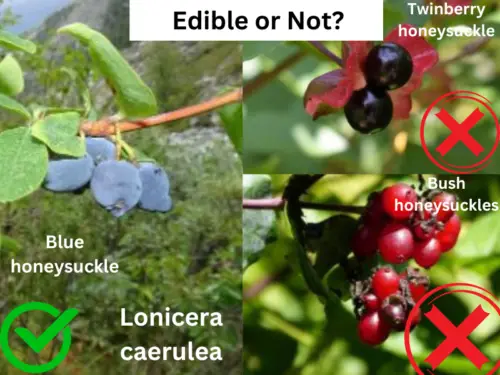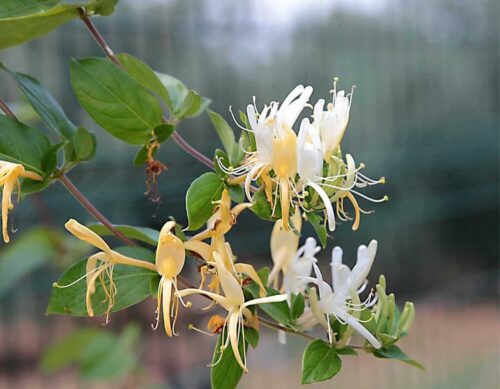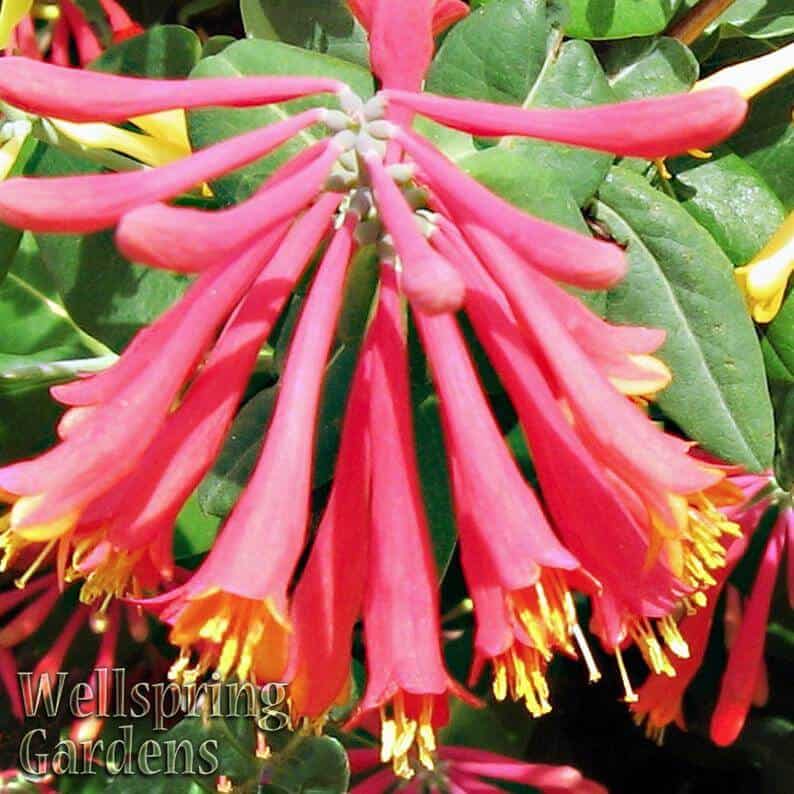Are Honeysuckle Berries Edible or Toxic? Honeysuckle bush flowers bloom in spring and summer. Later, they turn into berries. Honeysuckle berries are unsafe to eat. Eating many can make you sick. Some honeysuckle types have blue berries, which are edible. But, the common invasive one isn’t safe. Only eat berries from known honeyberry shrubs. Others are toxic! Invasive honeysuckle has red berries in fall and winter.
Are they safe? Do they have nutrients? Deadly honeysuckle berries are dried in hay. If unsure, don’t eat berries or plants! Some honeysuckle species are mildly toxic. But, a few have edible berries. Lonicera caerulea has edible berries[1]. Taste isn’t reliable for safety. Honeysuckle berries are poisonous in large amounts. They can cause illness. Twinberry honeysuckle berries are poisonous[2]. They taste bitter and sour. European honeysuckle species also have toxic berries. In conclusion, honeysuckle berries vary in safety. Be cautious!
What are honeysuckle berries?
Honeyberries, or Haskaps, a type of fruiting Honeysuckle. They grow well in Pacific Northwest. They’re like blueberries, but easier to grow. No need for specific soil pH. They thrive in average garden soils. Good for zones 3 to 8. They love full sun but tolerate shade. Cross-pollination is crucial for good yield. Plant at least two different cultivars nearby. Four bushes of different varieties are ideal. More plants mean more berries.
Space them 6 to 8 ft. apart. Bees help with pollination. They’re great for small gardens. Group 1 varieties are for zones 3-6. Blue Velvet™ and Blue Moon™ are popular. Group 2 varieties offer more flexibility. From University of Saskatchewan’s breeding program. Several named selections available. Pair them for best fruit production. Prune honeyberries in winter. Fruit grows on 1-year-old wood.
Let them grow freely for 3-5 years. Prune them to maximize fruit production. Avoid pruning tips; it hampers fruiting. Berries ripen 2-3 weeks after turning blue. Protect them from birds with netting. Fertilize honeyberries for higher yields. Use balanced 10-10-10 fertilizer. Apply in spring and after harvest. Or use well-rotted manure annually. Honeyberries are accessible and productive. They’re rich in antioxidants. Consider adding them to your garden. Explore Jung Seed Company’s offerings.
Are honeysuckle berries edible?
Honeysuckle berries are NOT edible. They’re not tasty at all! Some berries are yellow or orange, not edible. Edible varieties typically have blue berries. Only eat berries from known honeyberry shrubs. Bush honeysuckles have no thorns, small seeds. Honeysuckle fruit is not like blackberries or raspberries. Only select honeysuckle plants make edible berries. Tartarian Honeysuckle berries are NOT edible.
Eating too many can cause illness. Berries contain pigments that brighten birds’ feathers. Honeysuckle berries are not safe to eat. Bush honeysuckle berries are mildly toxic. Twinberry honeysuckle berries are poisonous. Autumn Olive berries are edible. Leaves, flowers, seeds used medicinally. Some honeysuckle species have edible berries. Most honeysuckle berries are mildly poisonous. Birds can eat berries, not humans. ” Lonicera Magnifica” berries are for wild birds. In summary, most honeysuckle berries are not edible.

How to identify honeysuckle berries
Honeysuckle blooms are lovely and safe for humans to admire. ? But beware, the berries are not for eating! ?? They’re unsafe for pets too, including our feline friends. ? Several kinds of honeysuckle berries are poisonous. ☠️ These include the dwarf and Tartarian varieties. ? Eating them can lead to poisoning symptoms. ? Bush honeysuckle berries are mildly toxic to humans. ? Plus, they taste really bad! ? To help, learn to spot bush honeysuckles. ? We must control their spread for safety. ? There’s one edible honeysuckle species: the haskap. ? But it’s not so common. ?
Another type, twinberry honeysuckle, is native to the west. ? Its berries come in pairs. ?? Here’s a tip: only eat berries from known honeyberry shrubs. ? All other honeysuckle berries are toxic in large amounts! ☠️ Invasive honeysuckles have red berries in fall and winter. ?❄️ But are they edible or nutritious? ? Be cautious: only eat honeysuckle fruit you’re sure is safe. ?✅ Stick to ones grown in gardens or on berry farms. ?? Honeysuckle is sometimes used in herbal medicine. ? It’s generally low in toxicity. ? But it might upset your stomach and cause vomiting. ?
| Berry Color | Edible? |
|---|---|
| Red | No |
| Blue | Yes (Haskap) |
| Black | No |
| Other Colors | No |
Types of honeysuckle berries
Honeysuckle plants offer beauty, ease of care, and diversity. These plants come in vines or bushes, evergreen or deciduous. The genus Lonicera boasts 180 species in Caprifoliaceae family. Don’t worry, you don’t need hours of research anymore! Let’s explore the best honeysuckle species together:
- Alpine: It’s from European forests, ideal for Zones 5-7.
- Box: Chinese native, valued for evergreen foliage.
- Brown’s: A hybrid with smaller orange flowers, hardy in Zones 4-7.
- Burmese: A giant evergreen vine with huge berries.
- Goldflame: A hybrid with disease-resistant, gorgeous foliage.
- Honeyberry: Dense shrub with blue, antioxidant-rich fruits.
- Japanese: Fragrant vine, beware its vigorous growth.
- Morrow: Deciduous bushy specimen from Japan.
- Perfoliate: Unique with long flowers pollinated by hawk moths.
- Privet: Evergreen foliage similar to Box honeysuckle.
- Trumpet: Vining species with bright red flowers.
- Winter: Flowers in winter, adds fragrance to cold months.
- Woodbine: Versatile deciduous vine, can be ground cover.
Honeysuckles grow vigorously but can be managed with care. Always follow local laws regarding planting honeysuckles. Each species offers unique traits and beauty to your garden. Choose species suitable for your climate and space. Enjoy the fragrance, blooms, and wildlife they attract.

Which honeysuckles are edible?
There are 180+ honeysuckle species. ? Some are edible. Common and Japanese honeysuckles have tasty blooms. ? They’re safe. Ornamental garden types are good too. ? Enjoy them! Edible honeysuckle’s future is bright. ? It’s cold-hardy and easy to grow. Their fruit is rich in vitamins. ? Healthy and delicious! Edible honeysuckles bloom from June to August. ? Enjoy the sight! All honeysuckle flowers are fine. ? But for berries, be cautious. Only eat from known honeyberry shrubs. ? Safety first! Some species may be edible. ? But be cautious. Avoid Japanese honeysuckle berries. ? They’re likely toxic. Our native honeysuckle’s berries are toxic. ? But flowers are safe. Common honeysuckle flowers are edible. ? Enjoy them in summer!
How to grow honeysuckle from seed?
To grow honeysuckle from seed, start by removing the red flesh. Clean the seeds with warm water and let them dry. As honeysuckle needs cold to sprout, sow in late autumn or refrigerate for 12 weeks. You can also sow directly into the soil. Prepare soil with compost or organic matter in early spring. If starting indoors, plant seeds about a quarter-inch deep. Place in a warm, sunny spot. In a greenhouse, seeds will germinate in 2 to 6 weeks. If no greenhouse, find a warm location. Collect seeds and sow them in potting soil or store indoors. Cut a 6-inch piece from a two-year-old vine. Plant in early spring after frost. If for ground cover, space plants 2-5 feet apart.
Are honeysuckle berries edible for birds
Honeysuckle berries: good or bad for our feathered friends? Well, birds seek high-protein food in autumn for energy. But munching on buckthorn and honeysuckle? Not ideal. It’s like opting for a sugary treat over nourishment. Invasive honeysuckle berries aren’t all bad. They’re a quick fix for hungry birds, but… Beware! These berries can be mildly poisonous.
Amur honeysuckle disrupts the environment as well. Yes, birds eat the berries, but… Native honeysuckle berries are more nutritious. Comparing them to “fast food” isn’t far off. The nectar? Sweet and safe for hummingbirds.
But those berries? Too risky to bother with. Crabapples, plums, and dogwoods are better options. Bush honeysuckle berries? Mildly toxic to humans. Edible honeysuckle varieties exist with blue berries. The common invasive one? Not edible, I’m afraid. Amur honeysuckle berries fall short on nourishment. Yet, birds still munch on them, aiding dispersal. Invasive honeysuckle bears red berries in fall. Edible or not? That’s the question. Birds, not picky, devour them, especially with winter near. But are they nutritious? Hmm, doubtful. Pollinating moths are drawn to honeysuckle’s sweet scent.
Birds like thrushes and warblers adore its berries. Birds feast, then spread the seeds, aiding plant growth. Honeysuckle berries offer carbs, but lack nutrients. Morrow’s honeysuckle? Birds love it, but it’s toxic. So, are honeysuckle berries really bird-friendly? They’re a snack, not a feast, for our avian pals.

Are honeysuckle berries edible for humans
Honeysuckle berries aren’t safe for humans due to toxicity. They taste bad and could make you sick. If you spot honeyberry shrubs, those berries are edible. But if unsure, it’s best to avoid eating them. Honeysuckle plants don’t have thorns like blackberries. The seeds are tiny and hardly noticeable. Honeysuckle blooms are fine, but not the berries. Pets should steer clear of all parts, too. Some varieties have edible blue berries, though.
The common invasive type isn’t edible. It’s crucial to know the difference. Eating too many can lead to poisoning. Be cautious, especially with small children. Enjoy the blooms, but skip the berries. Stay safe and happy exploring nature!

Red are honeysuckle berries
Honeysuckle berries come in different colors: red, yellow, orange. Bush honeysuckle berries are not edible, avoid consumption. Tartarian honeysuckle berries are NOT edible, remember this. Only eat berries from known honeyberry shrubs. The haskap honeysuckle species has edible berries. Ensure you identify the right honeysuckle shrubs. Avoid eating berries from other honeysuckle species.

Orange honeysuckle berries
Yes, orange honeysuckle berries are edible. They grow in dense clusters above round leaves. These berries appear from late spring to mid-summer. They turn into translucent, orange-red berries. You can eat them raw or cooked. Although not widely sought, they’re edible. They’re around 5mm in diameter. Children enjoy sucking nectar from the flower base. These berries are usually not as sought after as flowers. Orange honeysuckle thrives in various habitats. It’s cold hardy and easy to grow. These berries have high vitamin levels. They contain vitamins C, A, and E. Also, they have three times the antioxidants of oranges. Though not common, they’re edible. But remember, not all honeysuckle berries are edible. Some varieties might have blue berries. The invasive ones are typically not edible. So, enjoy the orange honeysuckle berries responsibly!
Multiple source quoted this information here are those –
https://pfaf.org/User/Plant.aspx?LatinName=Lonicera+ciliosa
https://www.gardenia.net/plant/lonicera-ciliosa#:~:text=Borne%20in%20dense%20terminal%20clusters,edible%20either%20raw%20or%20cooked.

Japanese honeysuckle berries
Japanese honeysuckle berries aren’t safe to eat. Avoid them. There’s just one type of honeysuckle with edible berries. It’s the haskap. Unlike blackberries, honeysuckle plants have no thorns. Plus, the seeds are tiny. Honeysuckle fruits may not taste as good as other berries. Waterberry or Mountain Fly Honeysuckle has edible berries. Only eat berries from known honeyberry shrubs. Crabapples, plums, and shrub dogwoods are good alternatives. Not all honeysuckle species have edible blossoms. Always verify the edibility of honeysuckle fruit. Berries of bush honeysuckles are mildly toxic.
FAQ’s
Are red honeysuckle berries edible?
Sadly, red honeysuckle berries aren’t edible. They’re not tasty and could be harmful. Some berries might look yellow or orange. These berries grow on dense shrubs. Shrubs can reach heights of 3 to 10 feet. Only a specific honeysuckle species has edible berries. This special species is called haskap.
Remember to eat berries from known honeyberry shrubs. Other honeysuckle berries could be toxic. They might cause harm if eaten in large amounts. Unlike raspberries, honeysuckle plants have no thorns. Seeds in honeysuckle berries are tiny. You might not even notice them when eating. Honeysuckle berries come in red, blue, or black. They typically contain several seeds. Most species of honeysuckle berries are mildly poisonous.
A few species have berries that are safe to eat. Enjoy the beautiful blooms, but avoid the berries. They’re not safe for human consumption. Pets, including cats, should also steer clear. Opt for other safe berries like crabapples or plums. Avoid berries from bush honeysuckle plants. They’re mildly toxic and taste bad. Remember, tartarian honeysuckle berries are NOT edible. They may look tempting but should be avoided. Stick to safe and delicious berries instead.
Are amur honeysuckle berries poisonous to dogs?
Amur honeysuckle berries might lead to problems for dogs. These berries carry potential dangers for our furry companions. Consuming them can result in gastrointestinal issues. From simple tummy troubles to more serious concerns.
Ingesting large amounts can even be fatal. The effects can range from upset stomachs to cyanide poisoning. Such poisoning can bring heart and breathing difficulties. In the worst cases, it may lead to death. If you haven’t already, it’s wise to remove the plant.
We must prioritize our pets’ safety above all. Border terriers, like many dogs, may be vulnerable. Their small size might make them more susceptible. Vomiting and diarrhea could be the first signs. It’s better to prevent such incidents if possible. Consider carefully managing your pet’s environment. Proactively keeping harmful plants out of reach helps. Honeysuckle, though beautiful, can pose risks. It’s classified as having low toxicity overall.
Yet, it can still trigger digestive issues in pets. Calls about such incidents are not uncommon. The berries may look appealing to our pets. But for them, it’s best to avoid temptation.
Carotenoids found in the berries aren’t safe for dogs. These compounds can’t be digested by our furry friends. They might cause discomfort and distress. But our vigilant care can prevent such scenarios. Honeysuckle plants contain cyanogenic glycosides. These substances can induce severe symptoms in dogs. Symptoms such as vomiting, irregular heartbeats, and diarrhea.
Final thoughts
I hope you enjoyed our blog about “Are Honeysuckle Berries Edible” and its varieties. Using our guide, you should now be able to identify honeysuckle berries quickly and easily. If you want to read more articles like this then check below.
Also Read :
Is Honeysuckle Poisonous to Dogs? – Bush, Coral, Japanese
When, How long & What Month Honeysuckle Bloom? (Answered)
Honeysuckle Vine – Care, Propagation, Pruning, Sale (Growing Guide)
Honeysuckle Problems: Pests And Diseases Information
Types of Honeysuckle – Unique & Different Colorful(Varieties)
Can You Eat Cactus – Edible & Non Edible List
Are Elephant Ears Edible (You Should Know Before Eating)
